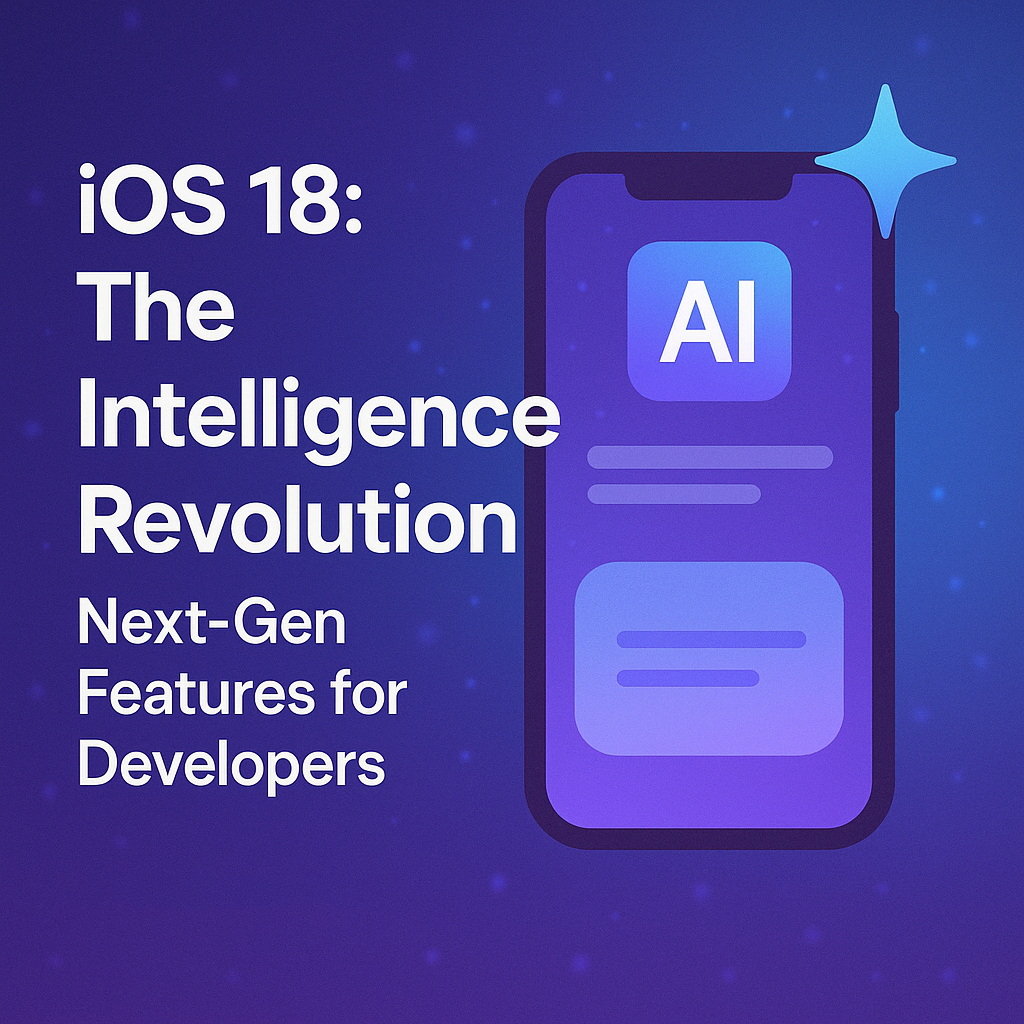iOS 18 marks the beginning of a new era in mobile computing. With the introduction of Apple Intelligence, revolutionary customization options, and unprecedented developer tools, Apple has redefined what's possible on a mobile device. This comprehensive guide explores everything developers need to know about building for the most intelligent iOS yet.

iOS 18 introduces Apple Intelligence - a personal AI system built into the core of iOS
Apple Intelligence: The AI Revolution
The headline feature of iOS 18 is undoubtedly Apple Intelligence - a deeply integrated AI system that transforms how users interact with their devices while maintaining Apple's commitment to privacy.
What is Apple Intelligence?
Apple Intelligence is an on-device AI system that provides contextual assistance across the entire operating system. Unlike cloud-based AI solutions, it processes data locally, ensuring user privacy while delivering intelligent features that feel magical.
Key Apple Intelligence Features for Developers
- Smart Suggestions API: Integrate AI-powered suggestions directly into your app's UI
- Context Awareness Framework: Access user context (with permission) to provide more relevant experiences
- Natural Language Processing: Enhanced NLP capabilities for understanding user intent
- Predictive Actions: Anticipate user needs and surface relevant features proactively
- Visual Intelligence: Advanced image and scene understanding for camera-based apps
Implementing Apple Intelligence in Your Apps
Here's how to integrate Apple Intelligence features into your iOS 18 apps:
import AppleIntelligence
import SwiftUI
struct IntelligentAssistantView: View {
@StateObject private var aiAssistant = AIAssistant()
@State private var userQuery = ""
@State private var suggestions: [AISuggestion] = []
var body: some View {
VStack {
// AI-powered search field
AISearchField(
text: $userQuery,
onCommit: performIntelligentSearch
)
.aiContextProvider(.userActivity)
.aiSuggestionStyle(.inline)
// Smart suggestions based on context
if !suggestions.isEmpty {
ScrollView(.horizontal, showsIndicators: false) {
HStack {
ForEach(suggestions) { suggestion in
SuggestionChip(suggestion: suggestion)
.onTapGesture {
applySmartSuggestion(suggestion)
}
}
}
.padding(.horizontal)
}
}
// AI-enhanced content view
AIContentView()
.intelligenceMode(.contextual)
.onIntelligentAction { action in
handleAIAction(action)
}
}
.onAppear {
requestIntelligencePermissions()
}
}
func performIntelligentSearch() {
Task {
// Use Apple Intelligence to understand intent
let intent = try await aiAssistant.analyzeIntent(from: userQuery)
// Get contextual suggestions
suggestions = try await aiAssistant.getSuggestions(
for: intent,
context: .current,
limit: 5
)
// Perform the search with AI enhancement
let results = try await aiAssistant.search(
query: userQuery,
withIntelligence: true,
filters: intent.suggestedFilters
)
}
}
}
// Custom AI Context Provider
struct UserActivityContextProvider: AIContextProvider {
func provideContext() async -> AIContext {
return AIContext(
recentActions: getUserRecentActions(),
preferences: getUserPreferences(),
currentTask: getCurrentUserTask()
)
}
}
Revolutionary Customization Features
iOS 18 introduces unprecedented customization options, allowing users to personalize their devices like never before while giving developers new ways to create adaptive interfaces.
Dynamic Home Screen
Adaptive App Icons
App icons can now dynamically change based on time of day, user activity, or app state. This creates a more personalized and contextual home screen experience.
// Dynamic App Icon Implementation
import UIKit
import AppleIntelligence
class AppIconManager {
static let shared = AppIconManager()
func updateIconBasedOnContext() {
Task {
let context = await AIContextProvider.current.getUserContext()
switch context.primaryActivity {
case .work:
UIApplication.shared.setAlternateIconName("WorkIcon")
case .fitness:
UIApplication.shared.setAlternateIconName("FitnessIcon")
case .relaxation:
UIApplication.shared.setAlternateIconName("RelaxIcon")
default:
UIApplication.shared.setAlternateIconName(nil) // Default icon
}
}
}
// AI-powered icon tinting
func applyIntelligentTint() async {
let dominantColor = await AIColorAnalyzer.analyzeWallpaper()
let tintColor = AIColorHarmonizer.generateComplementaryColor(for: dominantColor)
// Apply tint to adaptive icons
AdaptiveIconKit.setGlobalTint(tintColor)
}
}
Control Center 2.0
The completely redesigned Control Center in iOS 18 allows developers to create custom controls that users can add, resize, and arrange according to their preferences.
Pro Tip
Design your Control Center widgets to be resizable from 1x1 to 2x2 grid sizes. This gives users maximum flexibility in customizing their Control Center layout.
Enhanced Privacy with Intelligence
iOS 18 proves that intelligence and privacy can coexist. The new privacy features give users unprecedented control while enabling smart features.
Privacy-Preserving AI
| Feature | Traditional AI | Apple Intelligence |
|---|---|---|
| Processing Location | Cloud servers | On-device Neural Engine |
| Data Storage | Server databases | Encrypted local storage |
| Model Updates | Server-side updates | Differential privacy updates |
| User Control | Limited options | Granular permissions per feature |
| Data Sharing | Often required | Never leaves device |
App Privacy Report 2.0
The enhanced App Privacy Report now includes AI activity tracking, showing users exactly how apps use Apple Intelligence features.
Important for Developers
All AI-related activities must be declared in your app's privacy manifest. Failure to properly declare AI usage will result in app rejection during review.
SwiftUI 6: The Future of UI Development
iOS 18 ships with SwiftUI 6, bringing massive improvements to Apple's declarative UI framework.
New SwiftUI 6 Features
import SwiftUI
import SwiftUIAI
struct ModernAppView: View {
@State private var isIntelligentModeEnabled = true
@AIState private var userPreferences: UserPreferences
@Observable private var viewModel = AppViewModel()
var body: some View {
NavigationStack {
ScrollView {
LazyVStack(spacing: 20) {
// New AI-powered lazy loading
AILazyVGrid(
columns: adaptiveColumns,
intelligentPrefetch: true
) {
ForEach(viewModel.items) { item in
ItemCard(item: item)
.aiTransition(.smartMorph)
.aiContextMenu {
predictiveActions(for: item)
}
}
}
}
.scrollTargetBehavior(.aiPaging)
}
.navigationTitle("My App")
.navigationBarStyle(.intelligent) // Adapts based on content
.aiToolbar {
AIToolbarItemGroup(placement: .automatic) {
smartToolbarItems()
}
}
}
.aiTheme(.adaptive) // Automatically adjusts to user preferences
.onAIEvent { event in
handleIntelligentEvent(event)
}
}
// Adaptive grid that adjusts based on content and device
var adaptiveColumns: [GridItem] {
AIGridBuilder.optimalColumns(
for: viewModel.items,
minWidth: 150,
maxColumns: 5
)
}
// AI generates contextual menu items
@ViewBuilder
func predictiveActions(for item: Item) -> some View {
ForEach(AIActionPredictor.predict(for: item)) { action in
Button(action.title) {
performAction(action, on: item)
}
}
}
}
// New Observable macro for simpler state management
@Observable
class AppViewModel {
var items: [Item] = []
var isLoading = false
func loadItems() async {
isLoading = true
items = await APIClient.fetchItems()
isLoading = false
}
}
Game-Changing APIs and Frameworks
1. Live Activities 2.0
Live Activities now support interactive elements and can run indefinitely with smart battery management.
What's New in Live Activities
- Full interactivity with buttons, sliders, and gestures
- AI-powered content updates based on user behavior
- Cross-device synchronization via iCloud
- Advanced animations and transitions
- Persistent activities that survive reboots
2. RealityKit 4
iOS 18 brings spatial computing to iPhone with RealityKit 4, preparing developers for the future of AR experiences.
import RealityKit
import ARKit
import AppleIntelligence
struct ARExperienceView: View {
@StateObject private var arViewModel = ARViewModel()
var body: some View {
RealityView { content in
// AI-assisted object placement
let placementGuide = try await AIPlacementAssistant.suggestOptimalPosition(
for: .furniture,
in: content.scene
)
// Load 3D model with AI optimization
let model = try await Entity.loadAIOptimized(
named: "chair",
targetDevice: .current
)
model.position = placementGuide.position
model.enableAIInteractions()
content.add(model)
// AI-powered lighting
let lighting = AILightingSystem(scene: content.scene)
await lighting.analyzeEnvironment()
lighting.applyOptimalLighting()
}
.aiGestureTracking(.precise)
.onAISpatialEvent { event in
handleSpatialInteraction(event)
}
}
}
3. HealthKit AI Integration
HealthKit now includes AI-powered health insights and predictive analytics, enabling developers to create more intelligent health apps.
Privacy First
All health AI processing happens on-device. Apple never has access to user health data, and neither do third-party apps without explicit permission.
Performance and Optimization
iOS 18 introduces new tools and techniques for optimizing app performance, especially when using AI features.
AI Performance Profiler
Key Metrics to Monitor
- Neural Engine Utilization: Keep below 70% for smooth performance
- Memory Pressure: AI models can be memory-intensive
- Thermal State: Monitor device temperature during AI operations
- Battery Impact: Measure power consumption of AI features
- Inference Time: Track how long AI predictions take
Optimization Best Practices
// Efficient AI Feature Implementation
class AIFeatureManager {
private let aiQueue = DispatchQueue(label: "ai.processing", qos: .userInitiated)
private var cachedModels: [String: AIModel] = [:]
func processWithAI(
input: T,
using modelName: String
) async throws -> AIResult {
// Load model with caching
let model = try await loadOrCacheModel(modelName)
// Check device capabilities
let capabilities = await AIDevice.current.capabilities
// Adjust processing based on device
let processingMode: AIProcessingMode = {
switch capabilities.neuralEngineGeneration {
case .a17Pro, .a18, .m3, .m4:
return .highPerformance
case .a16, .a15:
return .balanced
default:
return .efficient
}
}()
// Process with automatic optimization
return try await model.process(
input,
mode: processingMode,
priority: .adaptive
)
}
private func loadOrCacheModel(_ name: String) async throws -> AIModel {
if let cached = cachedModels[name] {
return cached
}
let model = try await AIModel.load(
named: name,
optimization: .automatic
)
cachedModels[name] = model
return model
}
}
Preparing Your Apps for iOS 18
Migration Checklist
Essential Steps
- Update to Xcode 16 and test on iOS 18 beta
- Implement privacy manifests for AI features
- Adopt new customization APIs for icons and widgets
- Optimize for Apple Intelligence integration
- Update UI for new SwiftUI 6 capabilities
- Test performance with AI Performance Profiler
- Ensure backward compatibility with iOS 17
Future-Proofing Your Development
iOS 18 is clearly setting the stage for Apple's future platforms. Here's how to prepare:
Key Areas to Focus On
- Spatial Computing: Start experimenting with RealityKit 4
- AI-First Design: Build features that leverage on-device intelligence
- Privacy by Design: Make privacy a core feature, not an afterthought
- Adaptive Interfaces: Create UIs that adapt to user preferences and context
- Cross-Platform Thinking: Design for continuity across Apple devices
Conclusion
iOS 18 represents the most significant leap forward in iOS history. With Apple Intelligence at its core, revolutionary customization options, and powerful new developer tools, it opens up possibilities we've only dreamed of. The combination of intelligence and privacy, along with the enhanced SwiftUI 6 and new frameworks, provides developers with everything they need to create the next generation of mobile experiences.
As you begin developing for iOS 18, remember that the best apps will be those that thoughtfully integrate these new capabilities to solve real user problems. The intelligence features should enhance, not replace, good design and user experience principles.
The future of mobile development is here, and it's more intelligent, more personal, and more powerful than ever before. Welcome to iOS 18.

